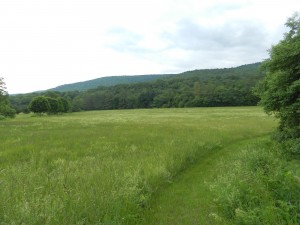
I’m obsessed with milkweed and Monarchs these days, and keep checking wild milkweed, hunting for hungry caterpillars.
Of course I read Eric Carle’s The Hungry Caterpillar to my children years ago. When they were in first grade, I watched their classroom Monarchs unfold, just as I witnessed them metamorphose into competent readers, writers and mathematicians. But in all my life, I’ve only found one chrysalis in the field – and that was last year.
Finding caterpillars everywhere . . .

This year is different. I’ve been out daily finding the black, white and yellow caterpillars feasting on milkweed leaves. I keep checking them, noting their growth, watching for them to encase themselves in what looks like a miniature, jewel-like sarcophagus that is in fact an organic chamber where the magic of metamorphosis occurs. It’s as if I’m in first grade, though instead of learning to read text, I’m learning to read the natural world.
. . . because milkweed is abundant here.

Milkweed grows in the margins of a sixty-acre pasture – a fragment of farmland that now has four houses on it, of which mine is one. The majority of the land is kept open with haying and mowing. I can identify some of the native hardwoods that populate the river terraces, providing habitat for deer, fox, moles and mice, and cardinals, chickadees, meadow larks, orioles, robins, sparrows, swallows, and wrens, among other fauna. The wild hedges in the margins between field and forest teem with flora, only a few of which I can identify. Milkweed is one.
Learning to read in the field, not by the book.
Despite attempting to learn the names of other wild plants by carrying a guide into the field, the plants whose names I remember are ones I can attach to experience: vines from which I’ve harvested wild grapes; poison ivy, from which I’ve suffered an itchy rash; and shiny-leafed buckthorn, an invasive, which I’ve weeded in an attempt to keep it from choking the goldenrod and aster.

I learned to recognize milkweed before I knew its connection to Monarchs, on account of how its seeds disperse on what appear to be white feathers floating on air. I traced those seeds backwards to their seed pods shaped like pelican beaks. Those, in turn, taught me to identify the milkweed’s mauve flower and sturdy leaf. But until I learned the connection between milkweed and Monarchs, I’d never paid much attention to either. Now I’m obsessed.
Like any first-grader learning to make connections between letters and sounds and words and meaning, it’s learning these connections between plants, animals and season that’s making the landscape I inhabit more legible.

Hi Deb,
I read an face book entry from Maggie Bills in Townshend saying she is observing stink bugs eating the caterpillars in her area! That is a very sad situation.
Elle
There is an attraction here in the Phoenix area called Butterfly Wonderland. Before entering the conservatory, there is a short 3-D film called “Flight of the Butterflies” that covers the monarch migration, as well as life cycle from egg to butterfly. I’ve seen it twice, and am still amazed by these amazing winged creatures.
Deborah,
Have you read Barbara Kingsolver’s novel ‘Flight Behaviour’? A novel about monarchs and milkweed!
x